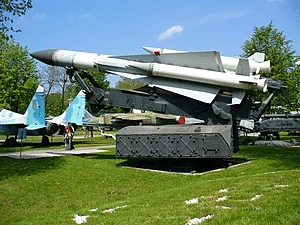On the evening of April 20, two Iranian Boeing 747 cargo planes landed at Damascus Airport. As we have already mentioned, those who monitor the movement of cargo planes from Iran to Syria are not surprised by the airstrikes that follow.
On April 22nd at about 01:40 (Israeli time), an Israeli airstrike was carried out by the Israeli Air Force in the a-Dumyer area near Damascus. The attack was apparently carried out in light of the landing of the Iranian cargo plane the day before and lasted about an hour. During the attack, anti-aircraft missiles were fired at Israeli Air Force planes. The remnants of one of the SA-5 missiles landed and exploded in the Israeli Negev region near the city of Beersheba (hundreds of kilometers from the missile launching area in Syria).
The SA-5 missile is an old Russian-made surface-to-air missile. Originally, the missile was designed to hit relatively heavy aircraft (transport planes). It is a missile that can reach a range of up to 400 km (about 260 miles) and an altitude of up to 13 km (about 40,000 feet). The missile carries a 200 kg warhead.

Following the numerous airstrikes on their territory in recent years, the Syrian Air Defense System has often launched SA-5 missiles. These missiles have “proven” that their firing results are unpredictable, and that when they do not hit their target and the mechanism of self-destruction does not work, they fly to the limit of their flight capability and fall to the ground:
- In March 2017, an SA-5 missile was intercepted by the Israeli defense system with an Arrow interceptor missile.
- In February 2018, an SA-5 missile hit and brought down an Israeli F-16 while another missile landed and exploded in Greek Cyprus.
- In September 2018, an SA-5 missile accidentally hit a Russian intelligence-gathering plane shooting it down over northwestern Syria.
- In June 2019, an SA-5 missile landed and exploded in Turkish Cyprus.
A Syrian SA-5 missile was launched during the attack, apparently from a launching Area south of Damascus. The missile didn’t hit its target. The missile’s trajectory was apparently over Jordanian territory and when reaching the Dead Sea area, it crossed southwest towards southern Israel. Israel’s air defense system responded to the SA- 5 but the interceptor missile did not hit. The remains of the SA-5 missile fell in southern Israel Near Beer Sheva and exploded. The missile’s fall was probably caused by the missile reaching the limit of its flight capability since the mechanism of self-destruction did not work.
The Syrian missile battery that fired the missile was attacked by the Israeli Air Force. The battery was destroyed and a number of Syrian soldiers were injured (as of now, there are reports confirming that there are wounded among the Syrian soldiers and that a Syrian officer with the rank of captain was killed).
Airstrikes in Syria are commonplace and retaliation by the Syrian air defense system of firing anti-aircraft is also a routine procedure. As we mentioned above, exceptional incidents occasionally occur.
It is important to clarify that despite the great tension that exists between the radical Shi’ite axis led by Iran and Israel, and despite publications in the media channels and social networks supporting the Shi’ite axis, tonight’s event is not an Iranian attempt to avenge recent events by firing a missile at a strategic target in Israel, such as the Israeli nuclear reactor located in Dimona (which is not far from where the remnants of the SA-5 missile fell).
There is a possibility that the moods and narrative in the publications of supporters of the Shiite axis will allow the decision-makers there to withdraw their desire for revenge against Israel…






